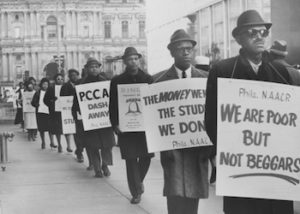
*On this date in 1963, the NAACP v. Button case was decided.
This was a 6-to-3 ruling by the United States Supreme Court, which held that the reservation of jurisdiction by a federal district court did not bar the U.S. Supreme Court from reviewing a state court's ruling. It also overturned specific laws enacted by the state of Virginia in 1956 as part of the massive resistance, as violating the First and Fourteenth Amendments to the United States Constitution.
The statutes here stricken down by the Supreme Court (and one overturned by the Virginia Supreme Court after 1959 had expanded the definitions of the traditional common law crimes of champerty and maintenance, as well as barratry, and had been targeted at the NAACP and its civil rights litigation. After the U.S. Supreme Court decisions in Brown v. Board of Education, especially the 1955 decision known as Brown II, which ordered federal courts to enforce the 1954 decision "with all deliberate speed," U.S. Senator Harry F. Byrd declared a policy of Massive Resistance to the desegregation of Virginia's schools.
Meanwhile, the National Association for the Advancement of Colored People (NAACP) filed legal challenges to segregation in various Virginia schools. Griffin v. County School Board of Prince Edward County had been filed in 1951 and became a companion case decided along with Brown. In January 1956, Virginia voters called for a limited state constitutional convention to allow tuition grants, which could be used at segregation academies and thus undercut the desegregation required by Brown. That constitutional convention was held in March 1956. The NAACP v. Button decision, which approved the NAACP's "test case" strategy, also led to the growth of public interest law firms with other goals, such as less-restrictive housing of the mentally ill and even contesting the No Child Left Behind Act.
However, those later class action cases also raised possible ethical problems of lawyers placing ideological motivations above client interests. The American Bar Association later adopted Model Rule of Professional Conduct 6.1 (applicable to lawyers working without charging clients) to distinguish those solicitations from others that violate legal ethics guidelines. However, Justice Thurgood Marshall criticized that approach as benefiting primarily white establishment attorneys who could afford to work without pay rather than increasing diversity within the bar, as NAACP practices had. Thus, in Ohralik v. Ohio State Bar Assn.,436 U.S. 447 (1978), the Supreme Court distinguished inappropriate for-profit client solicitations from the protected political speech in Button and the ACLU attorney in re Primus, whom it found South Carolina improperly prosecuted for offering legal services for free to a woman who was involuntarily sterilized.
Historic U.S. Cases 1690-1993:
An Encyclopedia New York
Copyright 1992 Garland Publishing, New York
ISBN 0-8240-4430-4